Overview
- Brief Narrative
- Gouache and watercolor painting created by Albert Dov Sigal when he lived in Israel from 1948-1958. It depicts, in a caricatured and light-hearted style, a schoolroom interior with a very large bearded teacher preparing to strike one boy with upraised arms with an extremely long strap while three other boys watch from a nearby table. In 1939, Sigal was arrested by the fascist, antisemitic Romanian government and assigned to a forced labor battalion that repaired and built roads and railways. He started an underground art school with a group of friends and was active in the Romanian resistance. On December 27, 1947, he and his family sailed from Burgas, Bulgaria, towards Palestine aboard the Aliyah Bet illegal immigrant ship, Pan York. Palestine was ruled by the British under a United Nations mandate and the postwar immigration policy was very restrictive. Ships attempting to bring unauthorized refugees to the country were stopped and the passengers were interned. Sigal, his wife, Rozi, and their young son, Daniel, were imprisoned in a detention camp on Cyprus on December 31, 1947. Because his son was only 18 months old, Sigal and his family were permitted to enter Palestine on February 22, 1948. On May 14, the state of Israel was established and, within six months, all the refugees on Cyprus were welcomed into the Jewish homeland.
- Artwork Title
- Malemend
- Date
-
creation:
1948-1958
- Geography
-
creation:
Israel
- Credit Line
- United States Holocaust Memorial Museum Collection, Gift of Rose Sigal Ibsen, In memory of my husband, Joseph P. Ibsen.
- Signature
- front, lower right, brown paint : Sigal
- Contributor
-
Artist:
Albert Dov Sigal
Subject: Albert Dov Sigal
Subject: Rose Sigal-Ibsen
- Biography
-
Albert Dov Sigal was born in 1912 in Cluj-Napoca (Koloszvar), in the Transylvania region, when it was part of Hungary and the Austro-Hungarian Empire. In the aftermath of World War I (1914-1918), it was conquered by Romania. His parents were Helen and Moses Sigal and he had a sister, Eda. His father died when he was three years old and though his mother worked hard to provide for the family, life was difficult and food was scarce. His family was not religious, though he attended synagogue. But from a young age, he was fascinated by the more joyful, communal life of the devout Hasidim. He joined the Maccabi Hatzair, a Zionist youth and sports organization. He graduated from the Academy of Fine Arts, specializing in painting, enameling, and copper engraving.
In 1933, he moved to Bucharest. Albert exhibited widely and his work was acquired by the National Museum in Bucharest. But by 1939, he could not get work. He was arrested and made part of a forced labor battalion that repaired and built roads and railways. He had a near-fatal construction accident and then bribed Romanian authorities to keep him from heavy forced labor, until a non-Jewish Romanian artist friend got him a position in a local museum, Pinacoteca Statului. He joined with a group of artists, led by Maxi, to begin an underground art school. Romania had a long tradition of vicious antisemitism which was emboldened by the rise of Nazi Germany. Following years of near civil war, General Antonescu and the fascist Iron Guard seized power in late 1940. Jewish businesses were confiscated, property destroyed, and physical attacks and the murder of Jews became commonplace. In January 1941, there were pogroms throughout the country; the one in Bucharest had events of great savagery, such as the assembly and murder of dozens of Jews, including Albert’s uncle-in-law, in the slaughterhouse.
In mid-1941, he married Rozi Cohn, who was active in the Zionist movement, Hanoar Hatzioni. She was born on August 22, 1922, in Bucharest to Joseph and Tili Cohn. She became a partner with Albert in his work, assisting in his workshop and at the art school. They opened a small jewelry business under a Gentile name. The couple rented a small attic apartment, but they had to move in with Rozi’s family when she became ill after an appendectomy in August 1941. Albert, Rozi, and her family were scheduled to be transported to concentration camps on multiple occasions, but many wealthy Jews in the area bribed the Romanian authorities to postpone the dates. The Allied bombings of Bucharest began on April 4, 1944. Most of Romania was liberated by the Soviet Army that spring and, after the overthrow of General Antonescu, an armistice was signed with the Soviets on August 23, 1944. They learned that Rozi’s family members in Moldavia had been deported to concentration camps in Transnistria, where they presumably perished. The majority of Albert’s family members in Transylvania also did not survive the Holocaust.
Albert reestablished his artistic career in postwar Bucharest. In 1946, his work was shown at the National Museum which also purchased his artwork and gave him an award. He and Rozi had a son, Daniel Moses, on June 26, 1946. But they decided that they could no longer live in Romania. That year, they received the affidavit of support required for United States immigration visas from Albert’s family there, but they feared being arrested by Soviet or Romanian authorities and destroyed the papers. Instead, they appealed to a distant relation of Rozi’s who worked with Romanian authorities to arrange emigration to Palestine for Jewish refugees. They received priority treatment because of Rozi’s Zionist connections. However, they had to bribe the Romanian authorities with jewelry to get added to the exit permit list. In addition to Rozi, Albert, and Daniel, his mother, her parents, her uncle, and her sister’s family and mother-in-law also wished to leave the country. They all left Romania and on December 27, 1947, sailed for Palestine from Burgas, Bulgaria, aboard the Aliyah Bet illegal immigrant ship, Pan York. The ship was stopped by the British authorities who controlled Palestine and the nearly 8000 passengers were imprisoned in detention camps in Cyprus on December 31, 1947. While in the camps Albert continued to create drawings, often of the daily life in the camps. He also began making brooches from Cypriot coins which he sold to supplement the family’s food rations. In early 1948, the British began preparations for withdrawal. They decided that refugees with children two years old or younger would be allowed into Palestine. After four weeks in the camp, Rozi’s sister, brother-in-law, and their child left for Palestine; Rozi, Albert, and their 18 month old son, Daniel, left two weeks later, on February 22. The remaining family members soon followed.
On May 14, 1948, the state of Israel was established. Albert was one of the first artists to establish himself in the new state. He achieved international acclaim as an expert in the art of enameling and renewed interest in this ancient craft of applying finely crushed glass to metal, heating it until it fuses with the metal, then painting it with special paints. He was noted for his mastery of copper engraving and woodcut from which he produced etchings and lithographs, as well for his painting, metalwork, and drawings in many media. Sigal specialized in Hebraic and Biblical enamel paintings and his work was deeply expressive of his religious faith as well as his faith in the history and future of Israel. In December 1957, the American Jewish Congress held his first one man show in the United States. Rozi came to view the exhibit and persuaded Albert to move to New York in 1959. He and Rozi became naturalized citizens in 1965. Their son, David, also became celebrated for his skill in the art of enameling. Albert died of leukemia, age 58, on May 30, 1970.
Rozi (Rose) Cohn was born on August 22, 1922, in Bucharest, Romania, to Joseph and Cecilia Cohn. She had three younger sisters: Berta, Yehudit, and Lidia. Rozi’s mother was a dressmaker. The family was not observant, but they celebrated all the Jewish holidays. Rozi’s family was poor, but many of her aunts were affluent. When she was six and a half, she went to live with her maternal aunt and uncle, Esther and Isaac, who owned a bookstore. After her uncle died in 1936, Rozi returned to her parent’s home. Her aunt also moved in and the household now numbered ten, as her grandmother, a cousin, and two servants also lived there. They lived in a gentile neighborhood and experienced some antisemitism. Rozi joined the Zionist movement and studied for two years to be a dressmaker. In 1939, she started working as a cashier in a store owned by a German company in Bucharest.
In September 1940, Romania came under the rule of a fascist military coalition led by General Antonescu and the Iron Guard, which enacted restrictive and violent anti-Jewish measures. In January 1941, Rozi and her family had to hide in their apartment for three days due to a vicious government assisted pogrom. Two of Rozi’s uncles were taken from the synagogue and along with dozens of other Jewish citizens, murdered by the Iron guard in the Bucharest slaughterhouse. Rozi was dismissed from her cashier job for being Jewish. In mid-1941, she married Albert Dov Sigal, born in 1912, in Cluj-Napoca. Albert was an artist and a master engraver, but he had been conscripted as forced labor to do road and railway repairs. The couple rented a small attic apartment, but they had to move in with Rozi’s family when she became ill after an appendectomy in August 1941. The local doctor refused to come to the home because the family was Jewish. Her German Christian brother-in-law was acquainted with a German soldier who brought medication for her from Italy.
Rozi and her family stayed hidden in their apartment in Bucharest, though Rozi was able to walk around without raising suspicion because she did not look Jewish. Albert bribed Romanian authorities to keep him from heavy forced labor and, with the assistance of a non-Jewish artist friend, received papers to work in a museum. He was active in the Romanian resistance and led an underground art school with about 20 other artists where Rozi often modeled. Albert, Rozi, and her family were scheduled to be transported to concentration camps on multiple occasions, but many wealthy Jews in the area bribed the Romanian authorities to postpone the dates. The Allied bombings of Bucharest began on April 4, 1944. Most of Romania was liberated by the Soviet Army that spring and after the overthrow of General Antonescu, an armistice was signed with the Soviets on August 23, 1944. The family discovered that the Cohn family members in Moldavia had been deported to concentration camps in Transnistria, where they presumably perished. The majority of Albert’s family members in Transylvania also did not survive the Holocaust.
Postwar Romania was chaotic and almost erupted into civil war. But by the end of 1945, an authoritarian Communist regime, backed by Stalin, was established. Rozi and Albert had a son, Daniel Moses, on June 26, 1946, in Bucharest. The family continued to be affected by the deeply entrenched anti-Semitism in Romania, and they decided that they must leave the country. In 1946, Rozi and Albert received the affidavit of support required for United States immigration visas from Albert’s family there, but they feared being arrested by Soviet or Romanian authorities and destroyed the papers. Instead, they appealed to a distant relation of Rozi’s who worked with Romanian authorities to arrange emigration to Palestine for Jewish refugees. Rozi and her family received priority treatment because of her involvement with Zionism, but they had to bribe Romanian authorities with jewelry to get added to the exit permit list. In addition to Rozi, Albert, and Daniel, her parents, her mother-in-law, her uncle, and her sister’s family and mother-in-law also wished to leave the country. They all left Romania and on December 27, 1947, sailed for Palestine from the port of Burgas in Bulgaria aboard the Aliyah Bet illegal immigrant ship, Pan York. The ship was stopped by the British authorities who controlled Palestine and the nearly 8000 passengers were imprisoned in detention camps in Cyprus on December 31, 1947. In early 1948, the British began preparations for withdrawal. They decided that refugees with children two years old or younger would be allowed into Palestine. After four weeks in the camp, Rozi’s sister, brother-in-law, and their child left for Palestine; Rozi, Albert, and their son, Daniel, left two weeks later, on February 22. The remaining family members soon followed. On May 14, 1948, the state of Israel was established.
In December 1957, the American Jewish Congress held Albert's first one man show in the United States. Rozi came to view the exhibit and persuaded Albert to move to New York in 1959. Rozi and Albert became naturalized citizens in 1965. Albert achieved international fame for his mastery of enamels. Their son, Daniel, also became celebrated for his skill in the art of enameling. Albert died on May 30, 1970, age 58. Rozi remarried Joseph Ibsen (1914-1991) in 1973. She is a frequently exhibited artist who specializes in Sumi-e brush painting and calligraphy.
Physical Details
- Classification
-
Art
- Category
-
Paintings
- Object Type
-
Gouache painting (lcsh)
- Physical Description
- Large gouache and watercolor painting over a pencil underdrawing on rectangular offwhite aged paper. In the left foreground, a young boy with a scared expression, sits at a desk wearing a green yarmulke and shirt; a large open book is on a table to the right. The boy’s hands are raised and he is turned away from an old bearded man who towers over him. The man has a long, thin face and is wearing a yarmulke and a long blue robe and a blue and white striped tallit. His arm is raised over his head, holding the buckle end of a belt, about to hit the boy. On the right, 3 young boys sit at a table, looking towards the other boy. In the left background is a stand with an open book and 2 lit candles. The back wall has a large, arched, open doorway with stained glass. Hebrew letters, the outline of a horse, and a stick figure are painted on the light brown walls. The artist’s signature is inscribed on the front. There is edge tape on the reverse.
- Dimensions
- overall: Height: 20.500 inches (52.07 cm) | Width: 15.625 inches (39.688 cm)
- Materials
- overall : paper, gouache, graphite
: pressure-sensitive tape
Rights & Restrictions
- Conditions on Access
- No restrictions on access
- Conditions on Use
- No restrictions on use
Keywords & Subjects
Administrative Notes
- Legal Status
- Permanent Collection
- Provenance
- The watercolor painting was donated to the United States Holocaust Memorial Museum in 1992 by Rose Sigal Ibsen, the widow of Albert Dov Sigal.
- Funding Note
- The cataloging of this artifact has been supported by a grant from the Conference on Jewish Material Claims Against Germany.
- Record last modified:
- 2022-07-28 18:21:47
- This page:
- https://collections.ushmm.org/search/catalog/irn5782
Download & Licensing
In-Person Research
- By Appointment
- Request 21 Days in Advance of Visit
- Plan a Research Visit
- Request to See This Object
Contact Us
Also in Albert Dov Sigal collection
The collection consists of artwork created by Albert Dov Sigal, some relating to his experiences in a British detention camp in Cyprus in 1948 and others on biblical themes or Jewish culture and his life in Israel.
Date: 1948-1959
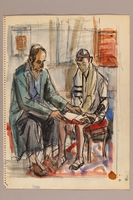
Albert Dov Sigal watercolor sketch of a boy in tallit and tefillin receiving religious instruction with a rough pencil sketch on the reverse
Object
Watercolor sketch created by Albert Dov Sigal from 1948-1958 when he lived in Israel. The painting shows a youth in tallit (prayer shawl) and tefillin (leather boxes containing Torah verses] holding a book and being instructed by an older man. It is a preparatory sketch for a later large oil painting of a Bar Mitzvah. There is a rough pencil sketch of a woman in her bath on the reverse which later became an enamel, Bathsheba. In 1939, Sigal was arrested by the fascist, antisemitic Romanian government and assigned to a forced labor battalion that repaired and built roads and railways. He started an underground art school with a group of friends and was active in the Romanian resistance. On December 27, 1947, he and his family sailed from Burgas, Bulgaria, towards Palestine aboard the Aliyah Bet illegal immigrant ship, Pan York. Palestine was ruled by the British under a United Nations mandate and the postwar immigration policy was very restrictive. Ships attempting to bring unauthorized refugees to the country were stopped and the passengers were interned. Sigal, his wife, Rozi, and their young son, Daniel, were imprisoned in a detention camp on Cyprus on December 31, 1947. Because his son was only 18 months old, Sigal and his family were permitted to enter Palestine on February 22, 1948. On May 14, the state of Israel was established and, within six months, all the refugees on Cyprus were welcomed into the Jewish homeland.
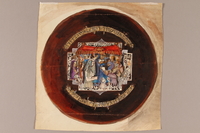
Albert Dov Sigal watercolor painting of a circular brown plate with a scene of a bride and groom standing in front of a rabbi under a red fringed chuppah
Object
Watercolor sketch created by Albert Dov Sigal from 1948-1958 when he lived in Israel. The work depicts a dark brown plate with a small rectangular scene of a woman in a white dress and veil with a man in a top hat beneath an red fringed wedding canopy with a Star of David on top held by 2 boys in yarmulkes; a rabbi reads from a paper while guests watch. It was created as a preparatory sketch for a woodcut that would be decorated with silver and enamel. It is a version of the scene portrayed in 1992.113.2. In 1939, Sigal was arrested by the fascist, antisemitic Romanian government and assigned to a forced labor battalion that repaired and built roads and railways. He started an underground art school with a group of friends and was active in the Romanian resistance. On December 27, 1947, he and his family sailed from Burgas, Bulgaria, towards Palestine aboard the Aliyah Bet illegal immigrant ship, Pan York. Palestine was ruled by the British under a United Nations mandate and the postwar immigration policy was very restrictive. Ships attempting to bring unauthorized refugees to the country were stopped and the passengers were interned. Sigal, his wife, Rozi, and their young son, Daniel, were imprisoned in a detention camp on Cyprus on December 31, 1947. Because his son was only 18 months old, Sigal and his family were permitted to enter Palestine on February 22, 1948. On May 14, the state of Israel was established and, within six months, all the refugees on Cyprus were welcomed into the Jewish homeland.
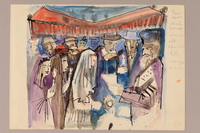
Albert Dov Sigal watercolor sketch of a rabbi with a bridal couple under an orange chuppah with guests holding lit candles with a rough pencil sketch on the reverse
Object
Watercolor sketch created by Albert Dov Sigal from 1948-1958 when he lived in Israel. The sketch depicts a woman in a white dress and veil with a man in a top hat standing in front of a rabbi reading from a paper under an orange wedding canopy. Behind them are guests in blues and purples holding lit candles. It was created as a preparatory sketch for a later work. It is a version of the scene portrayed in 1992.113.2. There is a sketch of a woman on the back. In 1939, Sigal was arrested by the fascist, antisemitic Romanian government and assigned to a forced labor battalion that repaired and built roads and railways. He started an underground art school with a group of friends and was active in the Romanian resistance. On December 27, 1947, he and his family sailed from Burgas, Bulgaria, towards Palestine aboard the Aliyah Bet illegal immigrant ship, Pan York. Palestine was ruled by the British under a United Nations mandate and the postwar immigration policy was very restrictive. Ships attempting to bring unauthorized refugees to the country were stopped and the passengers were interned. Sigal, his wife, Rozi, and their young son, Daniel, were imprisoned in a detention camp on Cyprus on December 31, 1947. Because his son was only 18 months old, Sigal and his family were permitted to enter Palestine on February 22, 1948. On May 14, the state of Israel was established and, within six months, all the refugees on Cyprus were welcomed into the Jewish homeland.
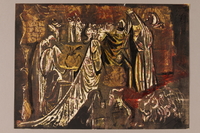
Albert Dov Sigal woodcut richly colored in white and golden browns featuring a woman in a heavy white robe presenting gifts to a king
Object
Woodcut created by Albert Dov Sigal in 1964 depicting a densely colored image of the Queen of Sheba, covered with a long white robe and veil, with attendants presenting gifts to King Solomon, who stands on a red raised platform. In 1939, Sigal was arrested by the fascist, antisemitic Romanian government and assigned to a forced labor battalion that repaired and built roads and railways. He started an underground art school with a group of friends and was active in the Romanian resistance. On December 27, 1947, he and his family sailed from Burgas, Bulgaria, towards Palestine aboard the Aliyah Bet illegal immigrant ship, Pan York. Palestine was ruled by the British under a United Nations mandate and the postwar immigration policy was very restrictive. Ships attempting to bring unauthorized refugees to the country were stopped and the passengers were interned. Sigal, his wife, Rozi, and their young son, Daniel, were imprisoned in a detention camp on Cyprus on December 31, 1947. Because his son was only 18 months old, Sigal and his family were permitted to enter Palestine on February 22, 1948. On May 14, the state of Israel was established and, within six months, all the refugees on Cyprus were welcomed into the Jewish homeland.
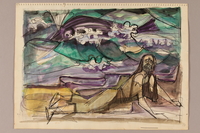
Albert Dov Sigal watercolor sketch of a man in tattered clothes with a large green and purple fish floating above with a pencil sketch on the reverse
Object
Watercolor sketch created by Albert Dov Sigal in 1964 with an image of Jonah lying on a beach, eyes closed in anguish; above and behind him is an abstract image of a whale floating in the green and purple sky. This is a preparatory sketch for an enamel. There are sketched scenes of Bathsheba in her bath on the reverse. In 1939, Sigal was arrested by the fascist, antisemitic Romanian government and assigned to a forced labor battalion that repaired and built roads and railways. He started an underground art school with a group of friends and was active in the Romanian resistance. On December 27, 1947, he and his family sailed from Burgas, Bulgaria, towards Palestine aboard the Aliyah Bet illegal immigrant ship, Pan York. Palestine was ruled by the British under a United Nations mandate and the postwar immigration policy was very restrictive. Ships attempting to bring unauthorized refugees to the country were stopped and the passengers were interned. Sigal, his wife, Rozi, and their young son, Daniel, were imprisoned in a detention camp on Cyprus on December 31, 1947. Because his son was only 18 months old, Sigal and his family were permitted to enter Palestine on February 22, 1948. On May 14, the state of Israel was established and, within six months, all the refugees on Cyprus were welcomed into the Jewish homeland.
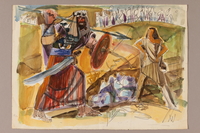
Albert Dov Sigal watercolor of a giant man with a shield, sword, and spear threatening an unarmed youth
Object
Watercolor sketch created by Albert Dov Sigal when he lived in Israel from 1948-1958. It depicts a Goliath, a large bearded man in a keffiyah, chestplate, and orange striped skirt threatening David, an unarmed youth in a white tunic standing, hands on hips, next to a small pile of rocks. In 1939, Sigal was arrested by the fascist, antisemitic Romanian government and assigned to a forced labor battalion that repaired and built roads and railways. He started an underground art school with a group of friends and was active in the Romanian resistance. On December 27, 1947, he and his family sailed from Burgas, Bulgaria, towards Palestine aboard the Aliyah Bet illegal immigrant ship, Pan York. Palestine was ruled by the British under a United Nations mandate and the postwar immigration policy was very restrictive. Ships attempting to bring unauthorized refugees to the country were stopped and the passengers were interned. Sigal, his wife, Rozi, and their young son, Daniel, were imprisoned in a detention camp on Cyprus on December 31, 1947. Because his son was only 18 months old, Sigal and his family were permitted to enter Palestine on February 22, 1948. On May 14, the state of Israel was established and, within six months, all the refugees on Cyprus were welcomed into the Jewish homeland.
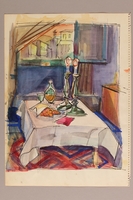
Albert Dov Sigal watercolor sketch of a Shabbat table with a decanter, kiddush cup, challah, and candlesticks with a pencil sketch on the reverse
Object
Watercolor painting created by Albert Dov Sigal when he lived in Israel from 1948-1958. It depicts a table set for the Sabbath with a wine decanter and kiddish cup, 2 candlesticks, and a challah with a traditional cover. This is the basis for a later painting and a favorite theme of Sigal's. There is a pencil sketch on the reverse of a man gazing upon a woman in her bath which later became an enamel, David watching Bathsheba. In 1939, Sigal was arrested by the fascist, antisemitic Romanian government and assigned to a forced labor battalion that repaired and built roads and railways. He started an underground art school with a group of friends and was active in the Romanian resistance. On December 27, 1947, he and his family sailed from Burgas, Bulgaria, towards Palestine aboard the Aliyah Bet illegal immigrant ship, Pan York. Palestine was ruled by the British under a United Nations mandate and the postwar immigration policy was very restrictive. Ships attempting to bring unauthorized refugees to the country were stopped and the passengers were interned. Sigal, his wife, Rozi, and their young son, Daniel, were imprisoned in a detention camp on Cyprus on December 31, 1947. Because his son was only 18 months old, Sigal and his family were permitted to enter Palestine on February 22, 1948. On May 14, the state of Israel was established and, within six months, all the refugees on Cyprus were welcomed into the Jewish homeland.
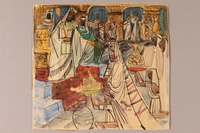
Albert Dov Sigal watercolor sketch of a woman in a headdress and gown attended by servants offering gifts to a king with a scepter
Object
Watercolor sketch created by Albert Dov Sigal when he lived in Israel from 1948-1958. It depicts the Queen of Sheba presenting her gifts to King Solomon who stands on an orange stepped platform, holding his scepter in one hand and reaching out with his other. In 1939, Sigal was arrested by the fascist, antisemitic Romanian government and assigned to a forced labor battalion that repaired and built roads and railways. He started an underground art school with a group of friends and was active in the Romanian resistance. On December 27, 1947, he and his family sailed from Burgas, Bulgaria, towards Palestine aboard the Aliyah Bet illegal immigrant ship, Pan York. Palestine was ruled by the British under a United Nations mandate and the postwar immigration policy was very restrictive. Ships attempting to bring unauthorized refugees to the country were stopped and the passengers were interned. Sigal, his wife, Rozi, and their young son, Daniel, were imprisoned in a detention camp on Cyprus on December 31, 1947. Because his son was only 18 months old, Sigal and his family were permitted to enter Palestine on February 22, 1948. On May 14, the state of Israel was established and, within six months, all the refugees on Cyprus were welcomed into the Jewish homeland.
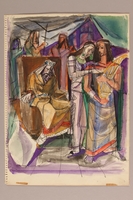
Albert Dov Sigal boldly colored watercolor sketch of a seated king gazing in sorrow at a couple standing before him
Object
Watercolor painting created by Albert Dov Sigal when he lived in Israel from 1948-1958. It depicts King Saul seated in his throne staring at a couple, David and Michal, Saul's daughter, standing before him. Michal's arm is across David's chest; he holds a lyre; her look is beseeching, his is cold and distant. It is a preparatory sketch for an enamel. In 1939, Sigal was arrested by the fascist, antisemitic Romanian government and assigned to a forced labor battalion that repaired and built roads and railways. He started an underground art school with a group of friends and was active in the Romanian resistance. On December 27, 1947, he and his family sailed from Burgas, Bulgaria, towards Palestine aboard the Aliyah Bet illegal immigrant ship, Pan York. Palestine was ruled by the British under a United Nations mandate and the postwar immigration policy was very restrictive. Ships attempting to bring unauthorized refugees to the country were stopped and the passengers were interned. Sigal, his wife, Rozi, and their young son, Daniel, were imprisoned in a detention camp on Cyprus on December 31, 1947. Because his son was only 18 months old, Sigal and his family were permitted to enter Palestine on February 22, 1948. On May 14, the state of Israel was established and, within six months, all the refugees on Cyprus were welcomed into the Jewish homeland.
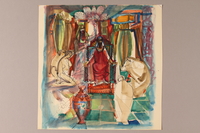
Albert Dov Sigal unfinished watercolor sketch of a king in red robes seated on his throne in an ornately decorated and colored interior
Object
Watercolor painting created by Albert Dov Sigal when he lived in Israel from 1948-1959. It depicts King Solomon in red robes seated on his throne being fanned by a black servant while other unfinished figures kneel nearby. The richly decorated interior is brightly colored in oranges, blues, and greens. In 1939, Sigal was arrested by the fascist, antisemitic Romanian government and assigned to a forced labor battalion that repaired and built roads and railways. He started an underground art school with a group of friends and was active in the Romanian resistance. On December 27, 1947, he and his family sailed from Burgas, Bulgaria, towards Palestine aboard the Aliyah Bet illegal immigrant ship, Pan York. Palestine was ruled by the British under a United Nations mandate and the postwar immigration policy was very restrictive. Ships attempting to bring unauthorized refugees to the country were stopped and the passengers were interned. Sigal, his wife, Rozi, and their young son, Daniel, were imprisoned in a detention camp on Cyprus on December 31, 1947. Because his son was only 18 months old, Sigal and his family were permitted to enter Palestine on February 22, 1948. On May 14, the state of Israel was established and, within six months, all the refugees on Cyprus were welcomed into the Jewish homeland.
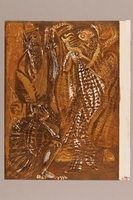
Albert Dov Sigal gouache and gold leaf painting of a seated man gazing at a large golden lion and another man with his finger raised in admonishment
Object
Gouache created by Albert Dov Sigal when he lived in Israel from 1948-1958. The stylized, abstract composition in gold and brown has an image of a man seated before a large golden lion with a cloth in its bared teeth. Next to the lion stands a man with his forearm raised, finger pointing upward. In 1939, Sigal was arrested by the fascist, antisemitic Romanian government and assigned to a forced labor battalion that repaired and built roads and railways. He started an underground art school with a group of friends and was active in the Romanian resistance. On December 27, 1947, the family sailed from Burgas, Bulgaria, towards Palestine aboard the Aliyah Bet illegal immigrant ship, Pan York. They were imprisoned by the British on Cyprus on December 31, 1947. Because his son was only 18 months old, Sigal and his family were permitted to enter Palestine on February 22, 1948. On May 14, the state of Israel was established and, within six months, all the refugees on Cyprus were welcomed into the Jewish homeland.
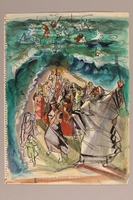
Albert Dov Sigal watercolor sketch of a bearded man leading one group of people through a parted sea while others float away
Object
Watercolor sketch created by Albert Dov Sigal when he lived in Israel from 1948-1958. It depicts Moses leading his people through the parted Red Sea as soldiers and chariots float in the background where the sea has closed. This is a preparatory sketch for a large oil painting. In 1939, Sigal was arrested by the fascist, antisemitic Romanian government and assigned to a forced labor battalion that repaired and built roads and railways. He started an underground art school with a group of friends and was active in the Romanian resistance. On December 27, 1947, he and his family sailed from Burgas, Bulgaria, towards Palestine aboard the Aliyah Bet illegal immigrant ship, Pan York. Palestine was ruled by the British under a United Nations mandate and the postwar immigration policy was very restrictive. Ships attempting to bring unauthorized refugees to the country were stopped and the passengers were interned. Sigal, his wife, Rozi, and their young son, Daniel, were imprisoned in a detention camp on Cyprus on December 31, 1947. Because his son was only 18 months old, Sigal and his family were permitted to enter Palestine on February 22, 1948. On May 14, the state of Israel was established and, within six months, all the refugees on Cyprus were welcomed into the Jewish homeland.
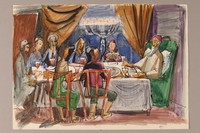
Albert Dov Sigal watercolor sketch of a bearded man in a green chair and a family seated around a Passover table with a pencil sketch on the reverse
Object
Watercolor painting created by Albert Dov Sigal when he lived in Israel from 1948-1958. It depicts an interior scene of a Jewish family with a bearded man in a red yarmulke seated in a green chair at the head of a table set for Passover, with a large lit candelabrum in the background. There is a preparatory pencil sketch on the reverse. In 1939, Sigal was arrested by the fascist, antisemitic Romanian government and assigned to a forced labor battalion that repaired and built roads and railways. He started an underground art school with a group of friends and was active in the Romanian resistance. On December 27, 1947, he and his family sailed from Burgas, Bulgaria, towards Palestine aboard the Aliyah Bet illegal immigrant ship, Pan York. Palestine was ruled by the British under a United Nations mandate and the postwar immigration policy was very restrictive. Ships attempting to bring unauthorized refugees to the country were stopped and the passengers were interned. Sigal, his wife, Rozi, and their young son, Daniel, were imprisoned in a detention camp on Cyprus on December 31, 1947. Because his son was only 18 months old, Sigal and his family were permitted to enter Palestine on February 22, 1948. On May 14, the state of Israel was established and, within six months, all the refugees on Cyprus were welcomed into the Jewish homeland.
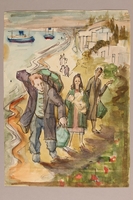
Albert Dov Sigal muted watercolor painting of a young woman, holding an infant, walking with her family on a seaside road based upon his arrival in Palestine
Object
Watercolor painting created by Albert Dov Sigal based upon the experiences of his family as newly arrived emigrants to Palestine on February 22, 1948. It depicts the artist and his family as they arrive in their new home. It is an image of a man with bags, followed by two women, one with a baby, with a small village in the background. This was a preparatory sketch for a lithograph. See 1990.242.2 and 1990.242.4 for other versions of this scene. In 1939, Sigal was arrested by the fascist, antisemitic Romanian government and assigned to a forced labor battalion that repaired and built roads and railways. He started an underground art school with a group of friends and was active in the Romanian resistance. On December 27, 1947, he and his family sailed from Burgas, Bulgaria, towards Palestine aboard the Aliyah Bet illegal immigrant ship, Pan York. Palestine was ruled by the British under a United Nations mandate and the postwar immigration policy was very restrictive. Ships attempting to bring unauthorized refugees to the country were stopped and the passengers were interned. Sigal, his wife, Rozi, and their young son, Daniel, were imprisoned in a detention camp on Cyprus on December 31, 1947. Because his son was only 18 months old, Sigal and his family were permitted to enter Palestine on February 22, 1948. On May 14, the state of Israel was established and, within six months, all the refugees on Cyprus were welcomed into the Jewish homeland.
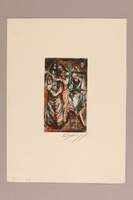
Albert Dov Sigal small red and green colored etching of a couple standing with heads touching next to a seated dejected man with a crown
Object
Etched print created by Albert Dov Sigal when he lived in Israel from 1948-1958. It presents David standing with Michal, Saul's daughter, their heads touching; her arm is across his chest and he holds a lyre. Next to them is a downcast, bearded King Saul seated in a large chair. This is a preparatory drawing for a copper engraving. It is similar to the watercolor sketch, 1992.113.9. In 1939, Sigal was arrested by the fascist, antisemitic Romanian government and assigned to a forced labor battalion that repaired and built roads and railways. He started an underground art school with a group of friends and was active in the Romanian resistance. On December 27, 1947, he and his family sailed from Burgas, Bulgaria, towards Palestine aboard the Aliyah Bet illegal immigrant ship, Pan York. Palestine was ruled by the British under a United Nations mandate and the postwar immigration policy was very restrictive. Ships attempting to bring unauthorized refugees to the country were stopped and the passengers were interned. Sigal, his wife, Rozi, and their young son, Daniel, were imprisoned in a detention camp on Cyprus on December 31, 1947. Because his son was only 18 months old, Sigal and his family were permitted to enter Palestine on February 22, 1948. On May 14, the state of Israel was established and, within six months, all the refugees on Cyprus were welcomed into the Jewish homeland.



